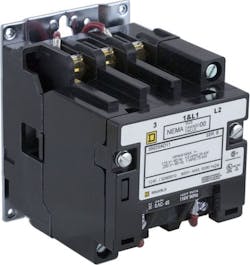NEMA General-Purpose Contactors Switching Dry Type Transformers
In many electrical installations, general-purpose contactors are used to switch the supply voltage to a small dry-type transformer on and off. One common reason this is done is for area lighting control. The typical wiring arrangement is to have a 480V, 3-phase, general-purpose contactor located in an electrical room, and it is controlled by a Hand-Off-Auto control station. The pilot device in the Auto position is typically either a photocell or time switch. The transformer — and subsequently the lighting panelboard downstream — can then be switched off and on without having to use many large lighting contactors (6- or 12-pole, etc.) for individual branch circuits downstream of the panelboard.
So what is the correct method for determining the minimum size NEMA contactor that will be required to switch the transformer power on and off? First, let’s start with finding the continuous current carrying amperes of the transformer. For this example, let’s use a 30kVA, 3-phase, transformer with a 480V delta primary stepping down the voltage to 208/120V wye secondary.
I PRIMARY = 30,000VA ÷ (480V x 1.732) = 36A
In NEMA ICS 2 (R2005) [a free electronic download can be found at www.nema.org], Table 2-4-17, we find that for a NEMA full-voltage, general-purpose contactor the continuous carrying current (RMS Amperes) for a NEMA Size 2 contactor is 45A maximum if enclosed in any type of enclosure and 50A maximum if open to free air. A common mistake is to stop at this point and use a NEMA Size 2 contactor since it appears at first glance to be adequate.
The second half of the Table (right-hand side) is dedicated to Transformer Primary Switching. It’s up to the designer to determine the inrush current on the transformer being used. This can typically be obtained from the manufacturer of the transformer. The wide majority of transformers in use today fit the left-hand column [Transformers Having Inrush Current (Worst Case Peak) of Not More Than 20 Times Peak of Continuous-Current Rating]. However, it’s not unheard of for some transformers to have an inrush 25 to 30 times the continuous current, in which case you’d have to refer to the far right columns of the Table. So make sure you know what the specifications on the transformer are when using this Table.
For our example above, let’s say the transformer has an inrush of 15X continuous-current, and it’s enclosed in a motor control center bucket. When we look to see what the maximum kVA rating of the transformer is for a given contactor, we see that in this case we’d have to go up to a NEMA Size 4. This is due to the inductive nature of a transformer load. Using anything less than a NEMA Size 4 for our transformer above would be a violation of Sec. 110.3(A) and (B) of the 2014 Edition of the NEC. Also, a contactor smaller than a NEMA Size 4 here would be unsafe, and the contactor surely would have a reduced life — if it worked at all.
© 2015 Fluor Corporation. All Rights Reserved.
About the Author
Eddie Guidry
Senior Fellow
Eddie Guidry is a senior fellow with Fluor Enterprises, Inc., Sugar Land, Texas. He is highly skilled in electrical and control systems for industrial construction, design, and engineering (both domestic and abroad). The majority of Eddie’s 38 years of experience includes upstream and downstream portions of petrochemical plants and refineries. He is also heavily experienced in water and wastewater treatment facilities. Eddie is very active in the development of U.S. national (ANSI) and international codes and standards, and has been a principal member of the National Fire Protection Association (NFPA) National Electrical Code (NEC) committee since 1999 and NFPA’s National Advisory Committee on Electrical Safety Research since 2008. Eddie, who has also developed and conducted many electrical courses and seminars over the years, currently holds the corporate Master Electrician license for Fluor Corporation in the State of Texas and is also an ICC/IAEI certified electrical inspector.

